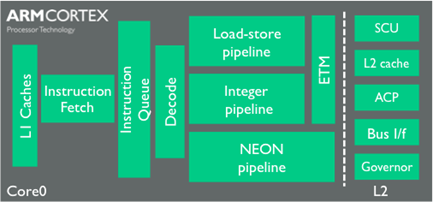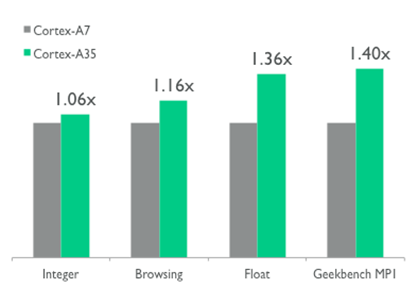Efficiency Improvements: Details
Cortex-A35 uses a combination of power reduction and performance improvements to deliver efficiency improvements compared to Cortex-A7. The Cortex-A35 consumes 10% lower active power when compared to Cortex-A7 for an iso-frequency implementation on 28nm. However, this comparison is for processors across different architecture generations – the Cortex-A7 is an ARMv7-A 32-bit processor whereas the Cortex-A35 is an ARMv8-A processor and supports both 64-bit and 32-bit compute capabilities.
Additionally, we can compare Cortex-A35 with Cortex-A53 (the first efficiency-maximizing ARMv8-A processor). The Cortex-A35 core is 25% smaller compared to the Cortex-A53 core for a typical configuration that includes 32k L1 caches, NEON, and crypto blocks. The Cortex-A35 consumes an impressive 32% lower power per core and is 25% more efficient compared to Cortex-A53. This makes Cortex-A35 the smallest, lowest power and most efficient ARMv8-A processor we have built.
So, how does Cortex-A35 reduce power consumption while simultaneously improving performance in the entry mobile power envelope?
Cortex-A35 has a redesigned in-order 8 stage pipeline that delivers significant efficiency improvements while providing full ARMv8-A support (capability to execute both A32/T32 and A64 instruction sets).
Here are some key micro architectural improvements in Cortex-A35 compared to Cortex-A7,
- Redesigned instruction fetch unit for maximizing efficiency
- High performance L1 and L2 memory subsystems resulting in up to 3.75x improvement in memory streaming performance
- Area efficient NEON and floating point pipelines with performance improvements for floating point and DSP operations
- Logic to support new power management features

The graph below depicts the relative performance improvements delivered by Cortex-A35 pipeline compared to Cortex-A7 across some of the popular benchmarks. To ensure a like-for-like performance comparison, the graph below compares only 32-bit code on Cortex-A35 and Cortex-A7, using the same processor configurations, and running at same clock frequency.

Cortex-A35 delivers overall 6% faster integer performance compared to Cortex-A7. The Cortex-A35 delivers 16% faster browsing performance compared to Cortex-A7.
It also delivers an impressive 36% overall improvement for floating point operations, which can translate into improved performance of apps like gaming that use floating point operations extensively.
If we look at the GeekBench single core benchmark, which includes the aggregate performance scores of integer, float and memory streaming tests, the Cortex-A35 processor delivers 40% performance improvement compared to Cortex-A7
To summarize the first key benefit: Cortex-A35 delivers higher performance while consuming lower power thereby providing a leap in efficiency improvements compared to the Cortex-A7.









